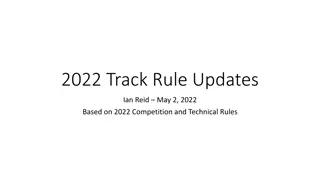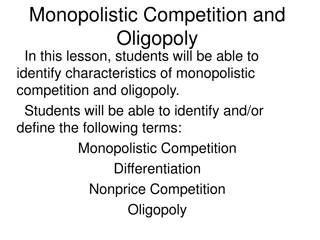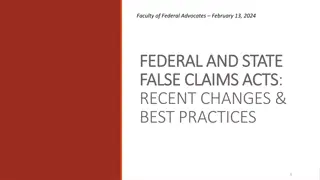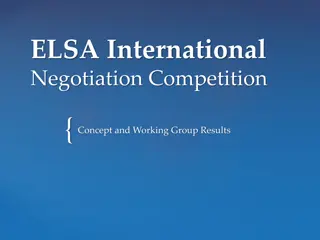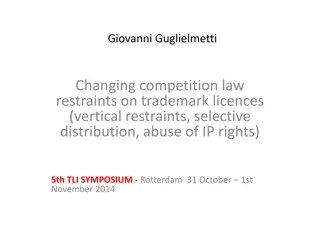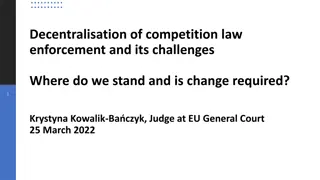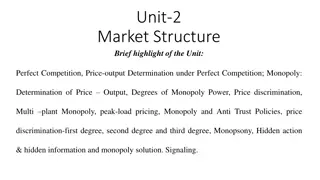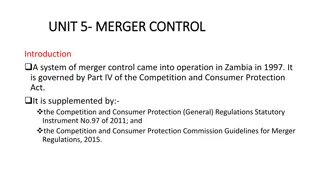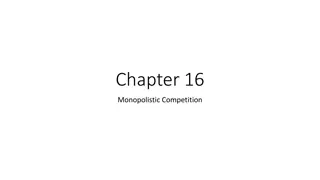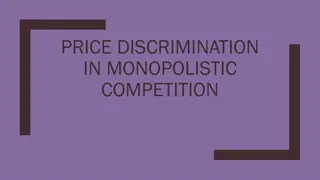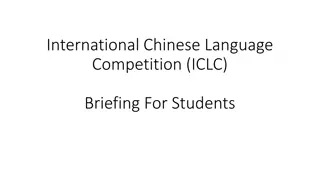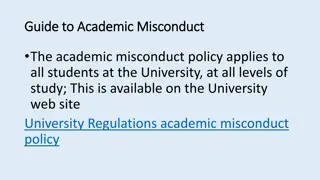Pecuniary Penalties for Competition Law Infringements in Australia
Explore the setting of pecuniary penalties for competition law violations in Australia compared to other jurisdictions around the world. The report discusses the drafting process, structure, penalty setting in Australia, international comparators, and recommendations.
Download Presentation

Please find below an Image/Link to download the presentation.
The content on the website is provided AS IS for your information and personal use only. It may not be sold, licensed, or shared on other websites without obtaining consent from the author. Download presentation by click this link. If you encounter any issues during the download, it is possible that the publisher has removed the file from their server.
E N D
Presentation Transcript
PECUNIARY PENALTIES FOR COMPETITION LAW INFRINGEMENTS IN AUSTRALIA Pedro Caro de Sousa and Sean Ennis Competition Expert and Senior Economist OECD 28 March 2018, Melbourne, Australia
Overview 1. Drafting the Report 2. Structure of the Report 3. Setting Pecuniary Penalties in Australia 4. Setting Pecuniary Penalties around the World 5. Comparison of Australian fines to hypothetical base penalties elsewhere 6. Recommendations 2
1. Drafting the Report The Various Steps Builds on 2016 OECD Global Forum on Competition Sanctions in Antitrust Cases Various Steps: Identify international best practices / comparator Carefully studying Australian Regime Fact-Finding Mission Analyse the Data and Draft the Report 3
1. Drafting the Report Selecting Comparators Goal A jurisdictions, providing a valuable mix of characteristics that reflect the variety of competition law regimes across the world and illustrate the breadth of approaches in different legal systems. good sample of established competition 4
1. Drafting the Report Australia Established public enforcement competition regime Criminal and other individual sanctions for infringements Medium-sized jurisdiction Common law jurisdiction Penalties set by courts Infringements evaluated by generalist courts 5
1. Drafting the Report Selecting Comparators Australia EU Germany Japan Korea United Kingdom USA Established Regime x x x x x x x Public Enforcement x x x x x x x Common law x - - - - x x Individual / Criminal Infringement x - x x x x x Medium-size x - x - x x - Judicially set penalties x - - - - - x Generalist courts x - x x x - x 6
Overview 1. Drafting the Report 2. Structure of the Report 3. Setting Pecuniary Penalties in Australia 4. Setting Pecuniary Penalties around the World 5. Comparison of Australian fines to hypothetical base penalties elsewhere 6. Recommendations 7
2. Structure of the Report Four Main Sections: I. Describing Australian Regime II. Describing Comparator Jurisdictions III. Comparing Australia and Comparator Jurisdictions IV. Conclusions and Recommendations 8
Overview 1. Drafting the Report 2. Structure of the Report 3. Setting Pecuniary Penalties in Australia 4. Setting Pecuniary Penalties around the World 5. Comparison of Australian fines to hypothetical base penalties elsewhere 6. Recommendations 9
Overview 3. Setting Pecuniary Penalties in Australia 3.1 Overview 3.2 Regulatory Outline 3.3 Legal Principles 3.4 Applicable Criteria 3.5 Agreed Settlements 10
3. Overview Federal Courts have power to set pecuniary penalties Accusatorial System (typical of common law) Can be civil or criminal Penalties set following a process of instinctivesynthesis Taking into account a large number of aggravating and mitigating criteria Practical importance of agreed penalties 11
3.2 Regulatory Outline Section 76 CCA key civil penalty provision. The greater of: AUD 10 million (only penalty pre-2007) Three times the gain from the contravention Where the gain cannot be readily ascertained, 10% of the annual turnover of the body corporate Section 79 CCA criminal penalty regime (after 2009) Identical to Section 76 regarding corporations (as per section 44 ZZRF and section 44AZZRG) A maximum 10-year jail sentence, a pecuniary penalty not exceeding 2,000 penalty units for individual offenders, or both 12
3.2 Regulatory Outline Object of Civil Penalties The principal, and I think probably the only, object of the penalties imposed by s 76 is to attempt to put a price on contravention that is sufficiently high to deter repetition by the contravenor and by others who might be tempted to contravene the Act (French J) Trade Practices Commission v CSR Ltd (1991) ATPR 41 076, para 52 The punishment must be fixed with a view to ensuring that the penalty is not such as to be regarded by that offender or others as an acceptable cost of doing business... those engaged in trade and commerce must be deterred from the cynical calculation involved in weighing up the risk of penalty against the profits to be made from contravention. Singtel Optus Pty Ltd v ACCC [2012] FCAFC 20, paras. 62-63, was endorsed by the High Court of Australia in ACCC v TPG Internet Pty Ltd [2013] HCA 54, para. 66. 13
3.3 Legal Principles No clear formula: instead, there is an extensive process to identify the appropriate penalty which varies from case to case ( instinctive synthesis ) Subject to a number of principles, including: Course of Conduct Principle Totality Principle Parity Principle Objective: To ensure that final / aggregate sanction is just and appropriate 14
3.4 Applicable Criteria Pecuniary penalties are set according to a number of criteria: Statutory (s. 76 (1) CCA) (i) the nature and extent of the act or omission; (ii) any loss or damage suffered as a result of the act or omission; (iii) the circumstances in which the act or omission took place; (iv) whether the person has previously been found by the courts to have engaged in any similar conduct in related proceedings. 15
3.4 Applicable Criteria Pecuniary penalties are set according to a number of criteria: Statutory (s. 76 (1) CCA) Case law (French criteria) (v) Size of the contravening company (vi) Market power of the contravening company (vii) Deliberateness of contravention and its duration; (viii) Involvement of senior management (ix) Corporate culture conducive to compliance, as evidenced by compliance programmes and corrective measures (x) Cooperation with the authorities (xi) Economic effects of the conduct (xii) Similar conduct in the past (xiii) Whether the conduct was systematic, deliberate or covert; (xiv) Financial position of the contravening company 16
3.4 Applicable Criteria Pecuniary penalties are set according to a number of criteria: Statutory (s. 76 (1) CCA) French criteria Additional factors taken into account in case law (xv) Expectation of very substantial penalties in other jurisdictions (xvi) Gain from unlawful conduct (xvii) Penalty submissions by the regulator (xviii) Avoiding the imposition of oppressive penalties 17
3.4 Applicable Criteria Pecuniary penalties are set according to a number of criteria: Statutory (s. 76 (1) CCA) French criteria Additional factors taken into account in case law But some criteria are of doubtful value: (xix) Corporate Group (xx) Punishment (xxi) Insolvency (xxii) Reputation 18
3.4 Applicable Criteria Pecuniary penalties are set according to a number of criteria: Statutory (s. 76 (1) CCA) French criteria Additional factors taken into account in case law Well-established Less well-established Overriding principle is that the court should weigh all relevant circumstances in the light of criteria and legal principles An instinctivesynthesis of many conflicting considerations The opposite of 'two-tiered' or 'sequential' approach, under which the decision-making process is compartmentalised, and particular factors isolated for the purpose of calculating their specific impact on the ultimate sanction 19
3.5 Agreed Penalties Setting of penalty is an exclusive prerogative of the courts But ACCC and respondents may jointly submit an agreed civil penalty (and other relief) for the courts consideration Decision is ultimately for the court Legal principles frame the courts evaluation (Commonwealth v Director, Fair Work Building Industry Inspectorate [2015] HCA 46) Practical effect is that agreed penalties tend to be accepted Question: is court satisfied that agreed penalty is appropriate, i.e. does it fall within a permissible range? ACCC submission expected to reflect a considered, but also pragmatic, estimation that the submission is apt to advance the public interest more effectively and efficiently that the continued prosecution of the claim If court is persuaded that it is an appropriate penalty, it is consistent with principle, and highly desirable in practice, for the court to accept the parties proposal and impose the agreed penalty 20
Overview 1. Drafting the Report 2. Structure of the Report 3. Setting Pecuniary Penalties in Australia 4. Setting Pecuniary Penalties around the World 5. Comparison of Australian fines to hypothetical base penalties elsewhere 6. Recommendations 21
Overview 4. Setting Pecuniary Penalties Around the World 4.1 Overview 4.2 Identifying a Base Fine 4.3 Aggravating and Mitigating Factors 4.4 Final Adjustments 22
4.1 Overview All jurisdictions have the ability to impose pecuniary penalties and other penalties Main goal of pecuniary penalties is deterrence All jurisdictions follow a set methodology, which is publicly available I. Set basic penalty, which reflects some measure of the economic impact of the competition infringement II. Apply a large number of mitigating or aggravating factors III. Final adjustments IV. Immunity and Leniency 23
4.2 The Base Penalty Two Fundamental Steps 1. Initial measure based on measures of: illegal gain from the anticompetitive conduct presumed damage to consumers 2. A rate applicable to this initial measure 24
4.2 The Base Penalty- Initial Measure Countries Initial Measure European Union Value of sales in the relevant market Germany Turnover infringement from sales connected with Japan Amount of sales or purchases of goods or services in question Korea Turnover of from the sale of goods or services in specific transaction areas United Kingdom Turnover in the relevant product and geographic market affected by the infringement USA Volume of commerce in goods or affected by the violation services 25
4.2 The Base Penalty - Rate Countries Initial Measure Maximum Rate European Union Value of sales 30% Germany Turnover 10% Japan Amount of sales or purchases 1%-10% Korea Turnover 0.5%-10% United Kingdom Turnover 30% USA Volume of commerce 20% 26
4.2 The Base Penalty Time Dimension Countries Initial Measure How Long Infringement period European Union Value of sales during last business year Infringement period Germany Turnover during infringement period Three Years Japan Value of sales during infringement period Infringement period Korea Turnover during infringement period Infringement period United Kingdom Turnover during last business year Infringement period USA Volume of commerce during infringement period 27
4.3 Aggravating Factors Common Aggravating Factors Australia Nature, extent and circumstances of the conduct (statutory) Leading Role Nature, extent and circumstances of the conduct (statutory) Coercive or Retaliatory Measures Deliberateness of contravention and its duration (French factors) Duration Nature, extent and circumstances of the conduct (statutory) Seriousness of conduct Whether the conduct was systematic, deliberate or covert (French factors) High Degree of Organisation Deliberateness of contravention and its duration (French factors) Intentional Conduct Involvement of Senior Management (French factors) Involvement of Senior Management Nature and Extent of the Act (statutory) Coercive or Retaliatory Measures - Obstruction Statutory and French factors Recidivism Size of the contravening company (French factors) Large Size of Firm Corporate Culture (French factors) Toleration of Criminal Activity - Breaching of Order 28
4.3 Mitigating Factors Common Aggravating Factors Australia Cooperation with the authorities (French factors) Acceptance of Responsibility Loss or damage caused by conduct (statutory) and Gains from unlawful conduct (case law) Compensation of Injured Parties Co-Operation with Authorities (French factors) Co-Operation with Authorities Corporate culture conducive to compliance (French factors) Effective Compliance Programme - Public Encouragement Nature, extent and circumstances of the conduct (statutory) and Deliberateness of contravention (French factors) Negligence Nature, extent and circumstances of the conduct (statutory) Minor Role Nature, extent and circumstances of the conduct (statutory) Non-implementation Nature, extent and circumstances of the conduct (statutory) Participation under Duress Corporate culture conducive to compliance (French factors) Self-Reporting Size of contravening company (French factors) Small Size of Firm Corporate culture conducive to compliance and Co-operation with authorities(French factors) Termination of Infringement - Uncertainty as to Unlawfulness 29
4.4 Final Adjustments Goals 1. Maximum Penalty 2. To Ensure: Adequacy Deterrence Main concern: Company Size 30
4.4The Base Penalty - Maximum Penalty Countries Initial Measure European Union 10% of total world-wide turnover during preceding business year Germany 10% of total world-wide turnover during preceding business year (5% if negligence) Japan N/A Korea Cartel: 10% of relevant turnover Abuse of dominance: 3% of relevant turnover United Kingdom 10% of total world-wide turnover during preceding business year USA Greatest of: USD 100 million, twice the pecuniary gains, or twice the pecuniary loss 31
Overview 1. Drafting the Report 2. Structure of the Report 3. Setting Pecuniary Penalties in Australia 4. Setting Pecuniary Penalties around the World 5. Comparison of Australian Fines to Hypothetical Base Penalties Elsewhere 6. Recommendations 32
Overview 5. Comparison of Australian fines to hypothetical base penalties elsewhere 5.1 Overview 5.2 Method 5.3 Analysis 5.4 Limitations 33
5.1 Overview How compare Australian penalties to those elsewhere? Absolute size of penalties: not relevant Market activities affected: relevant Illustrative exercise Apply external methods to calculate pecuniary penalty that would have applied to Australian conduct Difficult to apply instinctive synthesis methodology to compare penalties that would have been imposed under Australian approach to outside cases 34
5.1 Overview Size of Jurisdictions Population (millions) 23 GDP (billion USD) 1,169 Australia European Union 511.8 20,267 Germany 82.8 4,028 Japan 126.7 5,266 Korea 50.9 1,825 United Kingdom 65.8 2,796 United States 324 18,569 35
5.2 Method Focus group: cases not under appeal Make no judgment about guilt and actions Examine size of market activity Use this market activity as comparator for producing base fine in each of six examined jurisdictions Compare the base fine to actual fine Acknowledge limitations 36
5.3 Analysis Case Actual Penalty ACCC v Visy 36 million ACCC v Qantas 20 million ACCC v NSK 3 million ACCC v Colgate 18 million CPP v NYK Commonwealth 25 million (50 million without discount) 37
5.3 Analysis: Estimated Base Pecuniary Penalty Based on Jurisdiction s Method European Union Germany Korea Japan United Kingdom United States Case ACCC v Visy ACCC v Qantas ACCC v NSK ACCC v Colgate CPP v NYK Common wealth 1.272 b <1.06 b 371 m 318 m 1.06 b 1.06 b 103.3 m <221 m 31 m 22.1 m 88.6 m 88.6 m 13.9 m <9.28 m 3.2 m 4.64 m 9.28 m 9.28 m 117 m <117 m 27.3 m 39 m 78 m 78 m 800 m <900 m 210 m 300 m 600 m 600 m 38
5.4 Limitations Small number of cases Ignores difference in determining relevant turnover (e.g., annual turnover multiplied by time of infringement) Some conduct took place before Australia s 2007 and 2009 reforms Australian statute of limitations may affect duration and may not be taken into account Infringing party s sales or turnover taken from decision, may not have been deeply reviewed and contested, to the extent relevance to pecuniary penalty was limited 39
Overview 1. Drafting the Report 2. Structure of the Report 3. Setting Pecuniary Penalties in Australia 4. Setting Pecuniary Penalties around the World 5. Comparison of Australian fines to hypothetical base penalties elsewhere 6. Recommendations 40
Overview 6.Recommendations 6.1 Quantum 6.2 Legal Constraints 6.3 Methods for Setting Pecuniary Penalties 6.4 Transparency and Predictability 41
6.1 Quantum Increase awareness of international practices and reasons for these Focus on deterrence effects during ACCC negotiations and discussions Study potential to adopt mechanisms that link penalty to economic size of infringing corporation s conduct Study ways to ensure size of conduct is main criterion, and not excluded by precedence 42
6.2 Legal Constraints Consider ways of ensuring size of benefit or harm becomes a key element of consideration in penalty setting 43
6.3 Methods for Setting Pecuniary Penalties Adopt a structured approach to the setting of penalties Identify a base pecuniary penalty reflecting the size of the unlawful conduct, e.g. volume of commerce 44
6.4 Transparency and Predictability That ACCC submissions on quantum of penalty are those of a specialist regulator Consider adopting guidelines while respecting separation of powers and independence of judiciary Consider whether appropriate to reform law to provide method of calculation for penalties for civil pecuniary penalties applicable to economic agents for violation of competition law - and potentially other regulatory infringements 45
THANK YOU FOR LISTENING Pedro Caro de Sousa Competition Expert Competition Division, Directorate for Financial and Enterprise Affairs 2, rue Andr Pascal - 75775 Paris Cedex 16 Tel: +(33-1) 85 55 64 49 Fax: +33 1 45 24 96 95 pedro.carodesousa@oecd.org || www.oecd.org 46





